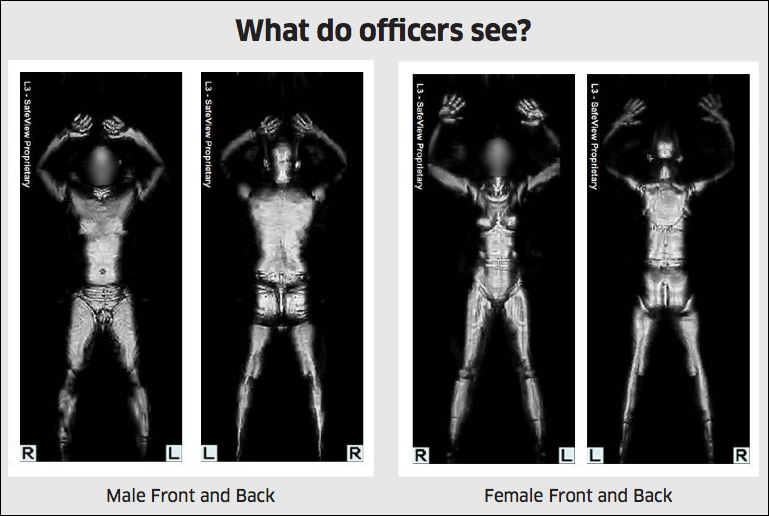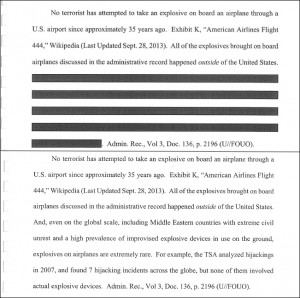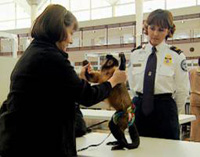TSA’s ‘Administrative Record’ admits ineffective security theater
Adan Salazar
Infowars.com
Oct. 17, 2013
Infowars.com
Oct. 17, 2013
The TSA has quietly admitted there is no actual “threat-addressing” basis for employing nude body scanners or invasive pat down procedures at airports, a notion many travelers who are weary of the federal agency’s borderline sexual molestation have long suspected but were hard-pressed to prove.

The TSA understands body scanners and pat downs are ineffective at addressing a threat for which they admit “there is no evidence.”
The evidence was found in sealed court documents, available through the PACER.gov website, regarding engineer and blogger Jon Corbett’s ongoing litigation over the constitutionality of the agency’s loathsome security practices.
In a redacted version of the appellant’s brief, filed by Corbett on October 7 with the United States Court of Appeals for the Eleventh Circuit, several portions of the Summary of Facts section were blacked out, raising questions as to the nature of the censored information.
But in a sealed version of the same documents obtained through PACER.gov (and available here), the redacted sections appear with incriminating clarity.
Through Redactions, TSA Admits Terror Threats are Slim to Nonexistent
“For example, the TSA analyzed hijackings in 2007 and found 7 hijacking incidents across the globe, but none of them involved actual explosive devices,” Corbett explains in the brief, adding that the last attempt to bring an explosive onboard an airplane through a U.S. airport occurred 35 years ago.
Another redacted section highlights the government’s concession that, “due to hardened cockpit doors and the willingness of passengers to challenge hijackers,” it would be difficult to have a repeat of 9/11.
“The government also credits updated pre-flight security for that difficulty assessment,” the brief states, “but the assessment was written before the en masse deployment of body scanners and before the update to the pat down procedure. Further, the government admits that there have been no attempted domestic hijackings of any kind in the 12 years since 9/11.”
The TSA also had the following section completely censored:
This begs the question, then, of what evidence the government possesses to rationalize that we should be so afraid of non-metallic explosives being brought aboard flights departing from the U.S. that we must sacrifice our civil liberties. The answer: there is none. “As of mid-2011, terrorist threat groups present in the Homeland are not known to be actively plotting against civil aviation targets or airports; instead, their focus is on fundraising, recruiting, and propagandizing.”
In the brief’s Summary of Argument, another redacted portion concerns the TSA’s understanding that body scanners and pat downs are ineffective at addressing a threat for which they admit “there is no evidence.”
By redacting certain parts of the brief, the TSA also inadvertently admits “it is aware of no one who is currently plotting a terror attack against our aviation system using explosives (non-metallic or otherwise),” and that, in addition to a cabin of empowered passengers who would make short work of a hijacker, the Federal Flight Deck Officer program, which arms pilots with firearms, makes targeting an airplane “to be the definition of insanity.”
Get the TSA Out of Our Pants
 The redactions in Corbett’s court documents are a damning indictment of the TSA’s procedures, and only serve to bolster his claims’ truthfulness.
The redactions in Corbett’s court documents are a damning indictment of the TSA’s procedures, and only serve to bolster his claims’ truthfulness.
The 28-year-old entrepreneur arrived at his conclusions after admittedly “pawing through several thousand pages of the TSA’s ‘administrative record,’” which he says the TSA uses as the “alleged rationale behind why they must photograph us naked and literally put their hands in our pants to search us.”
The information contained within the redacted portions support what Infowars and others have long suspected: that the sprawling agency – which is in the process of extending beyond the airport and onto highways, train stations and public buses – was never meant to thwart terrorists, but was instead set up to purposely obstruct, annoy, harass and train the American public.
In other words, the court documents go a long way in proving the TSA is pure contrived security theater custom-made solely to indoctrinate Americans, through prisoner training, into blindly accepting obedience to authority as a normal way of life, not to mention a huge waste of about $7.91 billion in taxpayer money a year.
Last year, he made headlines when he demonstrated how to thwart TSA body scanners simply by sewing an object onto clothing.
Corbett had also previously filed a lawsuit challenging the TSA after he was detained for an hour at the Fort Lauderdale-Hollywood International Airport. He also regularly adds updates regarding his ongoing litigation on his activist blog TSA Out Of Our Pants!.
Updates to Jon’s case can be found on PACER.gov, case #12-15893.
Below are both the redacted and sealed versions of the Appellant’s brief in the case of Jonathan Corbett v. Transportation Security Administration.
This article was posted: Thursday, October 17, 2013 at 1:24 pm


No comments:
Post a Comment